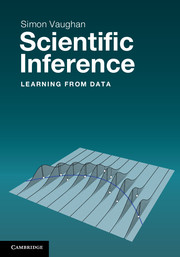Albert, J. (2007). Bayesian Computation with R. London: Springer.
Anscombe, F. J. (1973). Graphs in statistical analysis. American Statistician, 27, 17–21.
Bailey, N. T. J. (1967). The Mathematical Approach to Biology and Medicine. London: Wiley.
Barlow, R. J. (1989). Statistics: A Guide to the Use of Statistical Methods in the Physical Sciences (Manchester Physics Series), reprint edn. New York: Wiley-Blackwell.
Berger, J. O. and Berry, D. A. (1988). Statistical analysis and the illusion of objectivity. American Scientist, 76, 159–165.
Bolstad, W. M. (2007). Introduction to Bayesian Statistics. Hoboken, NJ: Wiley.
Bruntz, S. M., Cleveland, W. S., Kleiner, B. and Warner, J. L. (1974). The dependence of ambient ozone on solar radiation, wind, temperature, and mixing height. In Proceedings ofthe Symposium on Atmospheric Diffusion and Air Pollution. Boston, MA: American Meteorological Society, pp. 125-128.
Campbell, L. and Garnett, W. (1882). The Life ofJames Clerk Maxwell: With Selections from His Correspondence and Occasional Writings. London: Macmillan.
Casella, G. and Berger, R. (2001). Statistical Inference, 2nd edn. Pacific Grove, CA: Duxbury Resource Center.
Charles, P. A. and Coe, M. J. (2006). Optical, Ultraviolet and Infrared Observations of X-Ray Binaries. Cambridge: Cambridge University Press, pp. 215-265.
Cleveland, W. S. (1985). Elements of Graphing Data. Monterey, CA: Wadsworth.
Cleveland, W. S. (1993). Visualizing Data. Summit, NJ: Hobart.
Cowan, G. (1997). Statistical Data Analysis. Oxford: Clarendon.
Efron, B. (2005). Modern Science and the Bayesian-Frequentist Controversy, Division of Biostatistics technical report, Stanford University.
Efron, B. and Tibshirani, R. J. (1993). An Introduction to the Bootstrap. New York: Chapman & Hall.
Fienberg, S. E. (2006). When did Bayesian inference become ‘Bayesian’?Bayesian Analysis, 1, 1–40.
Gardner, M. (1977). Mathematical Carnival. New York: Vintage.
Gelman, A., Carlin, J. B., Stern, H. S. and Rubin, D. B. (2003). Bayesian Data Analysis, 2nd edn. London: Chapman & Hall/CRC.
Gentle, J. E. (2003). Random Number Generation and Monte Carlo Methods. Statistics and Computing Series. New York: Springer.
Gregory, P. C. (2005). Bayesian Logical Data Analysis for the Physical Sciences: A Comparative Approach with ‘Mathematica’ Support. Cambridge: Cambridge University Press.
GUM. (2008). Evaluation of Measurement Data - Guide to the Expression of Uncertainty in Measurement. Joint Committee for Guides in Metrology (JCGM) technical report.
Howson, C. and Urback, P. (1991). Bayesian reasoning in science. Nature, 350, 371–374.
James, F. (2006). Statistical Methods in Experimental Physics, 2nd edn. Singapore: World Scientific.
Jaynes, E. T. (2003). Probability Theory: The Logic ofScience. Cambridge: Cambridge University Press.
Jeffreys, H. (1961). Theory of Probability, 2nd edn. Oxford: Oxford University Press.
Jeffreys, W. H. and Berger, J. O. (1992). Ockham's razor and Bayesian analysis. American Scientist, 80, 64–72.
Lee, P. (2004). Bayesian Statistics: An Introduction, 3rd edn. London: Hodder.
Michelson, A. A. (1882). Experimental determination of the velocity of light: Made at the U.S. Naval Academy, Annapolis. [United States. Nautical Almanac Office.]Astronomical Papers, 1, 109–145.
Miller, I. and Miller, M. (2003). John E. Freund's Mathematical Statistics with Applications. Upper Saddle River, NJ: Prentice Hall.
Pedroni, E., Gabathuler, K., Domingo, J. J.et al. (1978). A study of charge independence and symmetry from π+ and π total cross sections on hydrogen and deuterium near the 3,3 resonance. Nuclear Physics A, 300, 321–347.
Perkins, D. H. (2000). Introduction to High Energy Physics, 4th edn. Cambridge: Cambridge University Press.
Perryman, M. A. C. and ESA (eds). (1997). The HIPPARCOS and TYCHO Catalogues. Astrometric and Photometric Star Catalogues Derived from the ESA HIPPARCOS Space Astrometry Mission. ESA Special Publication, vol. 1200.
Reynolds, O. (1883). On the experimental investigation of the circumstances which determine whether the motion of water in parallel channels shall be direct or sinuous and of the law of resistance in parallel channels. Philosophical Transactions ofthe Royal Society of London, 174, 935–982.
Russell, B. (1997). The Problems ofPhilosophy. New York: Oxford University Press.
Rutherford, E. and Geiger, H. (1910). The probability variations in the distribution of alpha particles. Philosophical Magazine, 20, 698–707.
Sivia, D. S. and Skilling, J. (2006). Data Analysis: A Bayesian Tutorial, 2nd edn. Oxford: Oxford University Press.
Stigler, S. M. (1977). Do robust estimators work with real data?The Annals of Statistics, 5(6), 1055-1098.
Tufte, E. R. (1986). The Visual Display of Quantitative Information. Cheshire, CT: Graphics.
Tukey, J. W. (1977). Exploratory Data Analysis. Reading, MA: Addison-Wesley.

 Loading metrics...
Loading metrics...


